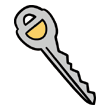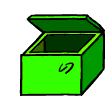|
|
- A- Ni' 'untsu kwthu luklitst?
|
Where is our key? |
- B- 'E'ut tthun' lukli'ulup.
|
Your (pl.) key is here. |
- A- Ni' 'untsu kwthu xthumtst?
|
Where is our box? |
- B- 'E'ut tthun' xthum'ulup.
|
Your (pl.) box is here. |
- A- Ni' 'untsu kwthun' lelum'ulup?
|
Where is your house? |
|
|
Our house is here. |
|
The first person plural possessive pronoun tst, which follows the noun, expresses the meaning "our".
| Ni' 'untsu kwthu lutemtst? |
"Where is our table (out of sight)?" |
| 'E'ut tthu lutemtst. |
"Our table is here (visible)." |
| Ni' 'untsu kwthu kaatst? |
"Where is our car (out of sight)? " |
| 'E'ut tthu kaatst. |
"Our car is here (visible)." |
The possessive pronoun un', which follows the article, expresses the meaning of second person possessive "your". In order to express the meaning of second person plural possessive, something that belongs to "you (pl.)", add 'ulup after the noun.
| Ni' 'untsu kwthun' lelum'ulup? |
"Where is your (pl.) house (out of sight)?" |
| 'E'ut tthun' lelum'ulup. |
"Your (pl.) house is here (visible)." |


